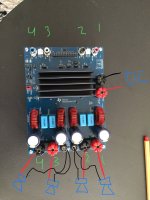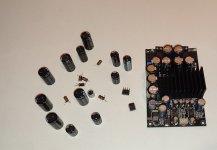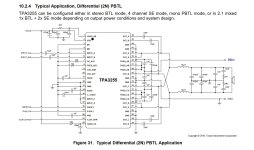Hi all,
what is the best suggested voltage to supply the Aiyima A07?
I have a 48V 10A SMPS, will it works good, or lower voltages work better?
I've read that with 32V it's smoother, over that it becomes harsher.
Thanks.
what is the best suggested voltage to supply the Aiyima A07?
I have a 48V 10A SMPS, will it works good, or lower voltages work better?
I've read that with 32V it's smoother, over that it becomes harsher.
Thanks.
I received my AVR Heos this morning.@mamocel did you receive yours? I got mine (new one from distributor). The wifi setup didn't work via WPS but after initial setup with cable and manually entering wifi settings it worked. Judging by the ear, it has similar sound signature to my old DIY TPA3255 amp. It is transparent, detailed and dynamic, I quite like it. The design is indeed great. I like the minimalist look of it, It looks like a stereo amplifier without tone control, just the volume. Running it in direct mode it does redirect bass to LFE output (it may do AD-DA for the low end but pass through the full range directly to the amp and front speakers). So far I like it.
It really is a beautiful amp with a minimalist front panel...
Afterwards, you must succeed in taming the machine via the HEOS application.
Great in HC....Average in streamer, my Hc PC does better for streaming, I send the sound via HDMI to the amp and it's much more musical!
The internal stereo dac of the amp's streamer is rather average...
In home cinema mode, I am completely satisfied with it. 👍
I had similar feeling streaming via optical (so using internal dac) from Android TV box. Maybe it is using the other dac (it has two) in this case. I'll try it with external dac in direct. Agree on HC, also I checked Dolby digital (not really listed in spec) and works well. Overall I got what Ive been looking for. Heos app could be better
It may also be the sound "mode" that is selected for internal streamer vs external input. (There is auto, stereo, multichannel stereo, direct, dts neo, etc...). The streamer itself shouldn't have any effect at all. It is just decoding bits. When it's connected via hdmi or optical, it is still using heos dac.
Last edited:
Just as a side note: for all the 08/15 ... standard boards, M.2 SSD coolers are pretty effective and relatively cheap.
I am unable to see how output 4.0 single ended operation negative terminal on speaker is connected. Anyone know?
As this?
As this?
Attachments
Last edited:
There's a dedicated thread to this Shui Yuan TPA3255 board.I bought this TPA3255 board.Are there any mods for it and points to be addressed?
View attachment 1218104
View attachment 1218102
Would be interested to know what caps you used as I have one of these and I am currently searching for capacitors to mod mine.I changed all of electrolitic capacitors and opamps, and I like the result.
Elna RFS 10uF 35V (silmic2 for coupling), Panasonic FC 820uF 25V, Panasonic OS-CON 560uF 16V, Panasonic FC 1000uF 16V, and the rest is NIC Components.
Great, thanks for the info. I was thinking along the same lines for the PSU caps (Panasonic FR's) with Nichicon FW's for the signal. Elna and OS-Cons are hard to get in the UK as the main suppliers don't actually want to hold stock, they only want to move what they have left. I'll have to have a look at the US suppliers (Mouser and Digikey)who hold a far better range.
I bought this parts from banzaimusic(dot)com (Germany)Elna and OS-Cons are hard to get in the UK as the main suppliers don't actually want to hold stock, they only want to move what they have left. I'll have to have a look at the US suppliers (Mouser and Digikey)who hold a far better range.
Hello guys, I just received my 350W power supply. It is based on L6599D unfortuntely not the l6599A. Voltage can be changed easy by potentiometer. It is 42V 8.5A out of the box. Looks not bad. Unfortunately I destroied the housing for looking inside. It will be used with Wondom Berry Bak BRU5 TPA3255. But why not also with other amps like Fever TPA3221 with lower voltage.


https://www.hifisentralen.no/forumet/threads/harepusens-nye-t-amp.96267/page-3I am unable to see how output 4.0 single ended operation negative terminal on speaker is connected. Anyone know?
As this?
🙂
I ordered a 4-channel TPA3255 amplifier board and intend to acquire a 48V 10A SMPS. As I am still learning, I am uncertain about the necessity of i. Digital Amplifier Speaker Protection Board and ii. BTSB iii. NE5532 Preamp board and iv. DC capacitor. My audio source is Tonewinner AT-300 with a balanced XLR output, and I prefer to have an XLR input on my amplifier.
i. Speaker Protection Board: Some claim that the TPA3255 has built-in speaker protection. Again, I am uncertain if my board require one?
ii. BTSB: Can I directly connect the board to this simple XLR female connector. Why do I even need BTSB like this one?
iii. Preamp board NE5532: Like this one, they appear NOT to have unbalanced XLR inputs, but I still like a crossover and volume control. I'll go without any preamp board.
iii. DC capacitor: do I need a cap? how to select one?
Sorry for the noob questions, some help would be a great help to build my first amp.
i. Speaker Protection Board: Some claim that the TPA3255 has built-in speaker protection. Again, I am uncertain if my board require one?
ii. BTSB: Can I directly connect the board to this simple XLR female connector. Why do I even need BTSB like this one?
iii. Preamp board NE5532: Like this one, they appear NOT to have unbalanced XLR inputs, but I still like a crossover and volume control. I'll go without any preamp board.
iii. DC capacitor: do I need a cap? how to select one?
Sorry for the noob questions, some help would be a great help to build my first amp.
Have you tried using this on the tpa 3255?Hello guys, I just received my 350W power supply. It is based on L6599D unfortuntely not the l6599A. Voltage can be changed easy by potentiometer. It is 42V 8.5A out of the box. Looks not bad. Unfortunately I destroied the housing for looking inside. It will be used with Wondom Berry Bak BRU5 TPA3255. But why not also with other amps like Fever TPA3221 with lower voltage.
View attachment 1221770View attachment 1221771
I would like to bridge an Aiyima A07 with one unique channel output and boosted up by the bridge connection. Power supply should be the 32V DC-DC supply the amp came with, because heat with the 48v supply is too much for the chip's heatsink.Yes, I understand that paralleling increases available output current while bridging increases the available voltage swing.
I think my question comes down to how the limit of the available rail voltage & current handling will bottleneck performance into a mono 8 ohm load depending upon how we connect the two BTLs.
If we drive an 8 ohm load using PBTL, each BTL will effectively see a 16 ohm load & each SE will effectively see a 8 ohm load. The datasheet does not specify any performance values for this operation, but if we extrapolate from the rated SE performance for a 4 ohm load at 1% THD with PVDD = 53.5V of 77W, we can assume roughy 40W for 8 ohm SE, so perhaps 160W total into our 8 ohm PBTL load.
If however we drive the same 8 ohm load by bridging the two BTLs, each BTL will effectively see a 4 ohm load & each SE will effectively see a 2 ohm load. The datasheet specifies 120W for 2 ohm SE (at the same 1% THD & 53.5V PVDD) & 255W for 4 ohm BTL. This would presumably give us >400W into our 8 ohm bridged load.
This is a big difference, so unless that >400W bridged output would actually be limited by some bottleneck that my calculations haven’t considered, the bridged approach would be far more preferable than PBTL? Presumably the issue is that bridging the BTLs just gets limited by the rail voltage?
So how do I implement that bridge? The TI datasheet shows PBTL option that seems to be the bridged mode implementation, but I am not sure it is. Is that really so?
Attachments
Your amp is already bridged... Only pbtl mode allows you to use both channels in mono mode.but I am not sure it is. Is that really so?
But the wiring of the M pins of the chip must be modified...
It's not within everyone's reach.
It is a parallel connection of the 2 channels, the power will be double if you divide the output impedance by 2.
Last edited:
- Home
- Amplifiers
- Class D
- TPA3255 - all about DIY, Discussion, Design etc


